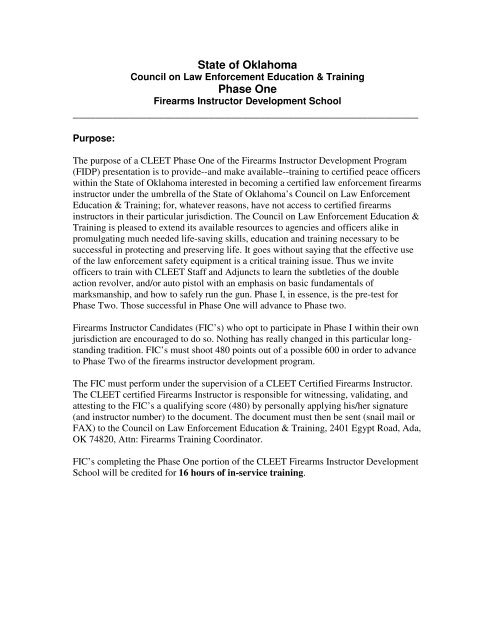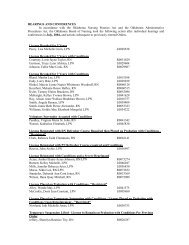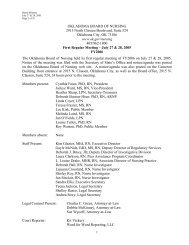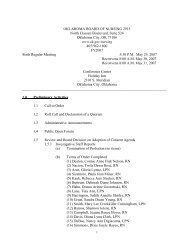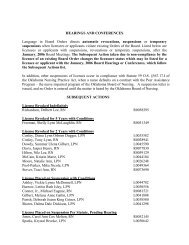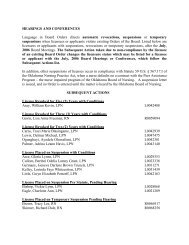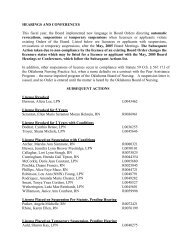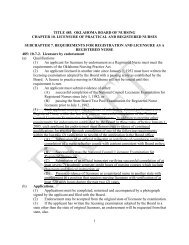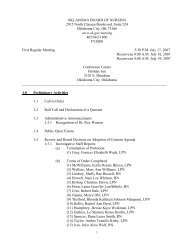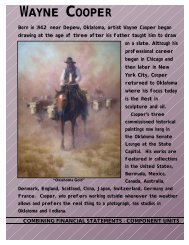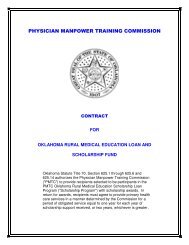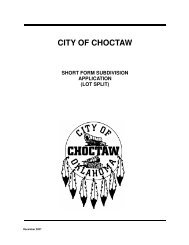Firearms Instructor School Phase I and Phase II - State of Oklahoma
Firearms Instructor School Phase I and Phase II - State of Oklahoma
Firearms Instructor School Phase I and Phase II - State of Oklahoma
You also want an ePaper? Increase the reach of your titles
YUMPU automatically turns print PDFs into web optimized ePapers that Google loves.
<strong>State</strong> <strong>of</strong> <strong>Oklahoma</strong><br />
Council on Law Enforcement Education & Training<br />
<strong>Phase</strong> One<br />
<strong>Firearms</strong> <strong>Instructor</strong> Development <strong>School</strong><br />
_____________________________________________________________<br />
Purpose:<br />
The purpose <strong>of</strong> a CLEET <strong>Phase</strong> One <strong>of</strong> the <strong>Firearms</strong> <strong>Instructor</strong> Development Program<br />
(FIDP) presentation is to provide--<strong>and</strong> make available--training to certified peace <strong>of</strong>ficers<br />
within the <strong>State</strong> <strong>of</strong> <strong>Oklahoma</strong> interested in becoming a certified law enforcement firearms<br />
instructor under the umbrella <strong>of</strong> the <strong>State</strong> <strong>of</strong> <strong>Oklahoma</strong>’s Council on Law Enforcement<br />
Education & Training; for, whatever reasons, have not access to certified firearms<br />
instructors in their particular jurisdiction. The Council on Law Enforcement Education &<br />
Training is pleased to extend its available resources to agencies <strong>and</strong> <strong>of</strong>ficers alike in<br />
promulgating much needed life-saving skills, education <strong>and</strong> training necessary to be<br />
successful in protecting <strong>and</strong> preserving life. It goes without saying that the effective use<br />
<strong>of</strong> the law enforcement safety equipment is a critical training issue. Thus we invite<br />
<strong>of</strong>ficers to train with CLEET Staff <strong>and</strong> Adjuncts to learn the subtleties <strong>of</strong> the double<br />
action revolver, <strong>and</strong>/or auto pistol with an emphasis on basic fundamentals <strong>of</strong><br />
marksmanship, <strong>and</strong> how to safely run the gun. <strong>Phase</strong> I, in essence, is the pre-test for<br />
<strong>Phase</strong> Two. Those successful in <strong>Phase</strong> One will advance to <strong>Phase</strong> two.<br />
<strong>Firearms</strong> <strong>Instructor</strong> C<strong>and</strong>idates (FIC’s) who opt to participate in <strong>Phase</strong> I within their own<br />
jurisdiction are encouraged to do so. Nothing has really changed in this particular longst<strong>and</strong>ing<br />
tradition. FIC’s must shoot 480 points out <strong>of</strong> a possible 600 in order to advance<br />
to <strong>Phase</strong> Two <strong>of</strong> the firearms instructor development program.<br />
The FIC must perform under the supervision <strong>of</strong> a CLEET Certified <strong>Firearms</strong> <strong>Instructor</strong>.<br />
The CLEET certified <strong>Firearms</strong> <strong>Instructor</strong> is responsible for witnessing, validating, <strong>and</strong><br />
attesting to the FIC’s a qualifying score (480) by personally applying his/her signature<br />
(<strong>and</strong> instructor number) to the document. The document must then be sent (snail mail or<br />
FAX) to the Council on Law Enforcement Education & Training, 2401 Egypt Road, Ada,<br />
OK 74820, Attn: <strong>Firearms</strong> Training Coordinator.<br />
FIC’s completing the <strong>Phase</strong> One portion <strong>of</strong> the CLEET <strong>Firearms</strong> <strong>Instructor</strong> Development<br />
<strong>School</strong> will be credited for 16 hours <strong>of</strong> in-service training.
Performance Objectives<br />
________________________________________________________________________<br />
1. The FIC will shoot a minimum <strong>of</strong> seven qualification scores for record.<br />
2. The FIC will perform prescribed reloads while competing in the PPC.<br />
3. The FIC will perform in the PPC with all due attention to the safe <strong>and</strong> careful<br />
management <strong>of</strong> weapons systems within his/her possession at all times.<br />
4. The FIC will identify the meaning <strong>of</strong> Squib Load, Misfire, <strong>and</strong> Hang Fire as it<br />
pertains to the safe operation <strong>of</strong> their firearms.<br />
5. The FIC will learn six basic fundamentals <strong>of</strong> marksmanship.<br />
6. The FIC will learn a variety <strong>of</strong> firing positions.<br />
7. The FIC will learn how to regulate adjustable Sights.<br />
8. The FIC will learn how to score targets.<br />
9. The FIC will respond affirmatively to all comm<strong>and</strong>s issued by the Tower.<br />
10. The FIC will score 480 points out <strong>of</strong> a possible 600 in order to advance to <strong>Phase</strong><br />
Two <strong>of</strong> the CLEET <strong>Firearms</strong> <strong>Instructor</strong> Development Program.
Equipment Requirements<br />
________________________________________________________________<br />
_______<br />
I. Student Equipment:<br />
A. ALP (Auto-Loading Pistol), Duty Size Configuration, e.g., Bear 1911<br />
Pattern Pistols; Beretta 92/90-TWO, 96, PX4/PX4-C (Constant Action),<br />
8000 Series; Brown 1911 Pattern Pistols; Colt 1911 Pattern Pistols;<br />
Enterprise 1911 Pattern Pistols; Glock 17/22/20/21/21SF/31/34/35/37;<br />
Heckler & Koch USP, LEM (Law Enforcement Modification) Series;<br />
Kimber 1911 Pattern Pistols; Para Ordnance 1911 Pattern Pistols; Ruger;<br />
Schweizerische-Industrie-Gesellschaft (S.I.G.)-Sauer P-220/26/250,<br />
Granite <strong>State</strong> Series 1911 Pattern Pistols, DAK (Double Action –<br />
Kellerman) Series; Smith & Wesson TDA’s, DOA’s, Model 945, 1911<br />
Pattern Pistols, M&P; Springfield Arms 1911 Pattern Pistols; XD/XD-M<br />
Series; STI 1911 Pattern Pistols, Wilson Combat 1911 Pattern Pistols<br />
REVOLVERS: Colt’s Python, Official Police, Trooper, Trooper Mk-<strong>II</strong>I,<br />
Cobra (Trooper Mk-<strong>II</strong>I Frame); Smith & Wesson K-Frame Models 15/67,<br />
19/66, L-Frame Models 586/686, N-Frame Models 25-4”/625-4” (24<br />
Full-Moon Clips), 27/627, 28, 610 (10mm/.40 S&W, 10mm, 24 Full-<br />
Moon Clips); Ruger Security Six, GP-100.<br />
Note: Revolvers used will be in four-inch (4”) configuration; operation -<br />
DA mode only.<br />
B. Holster : It is recommended that each FIC use a holster designed<br />
specifically for make <strong>and</strong> model <strong>of</strong> firearm employed to include trigger<br />
guard <strong>and</strong> retention devises (Threat Level One-Three), e.g., Blackhawk<br />
Serpa ARS (Active Retention System Level <strong>II</strong> & <strong>II</strong>I); Safaril<strong>and</strong> ALS,<br />
SLS, 6270 Fine-Tac Raptor, 070/SS-<strong>II</strong>I; Bianchi, for the sake <strong>of</strong> continuity<br />
<strong>of</strong> training (i.e., <strong>Phase</strong> IV)<br />
As we are using NRA rules, FIC’s may use a competition holster;<br />
however, the trigger <strong>of</strong> the FIC’s auto-loading pistol must be covered by a<br />
trigger guard that is inherent <strong>of</strong> the holster’s design.<br />
C. Magazines/Speed-Loaders:<br />
1. Single Stack ALP’s: Four (4) Magazines, Minimum<br />
2. High Capacity ALP’s: Three (3) Magazines, Minimum<br />
3. Speed-Loaders: Three (3) Minimum<br />
Note: FIC’s may bring as many loading devices as they wish. To<br />
enhance accountability, please mark magazines/speed-loaders with an<br />
electric scribe, a silver/black Sharpie--or some other means--to insure<br />
positive identification.
C. Magazine/ Speed-Loader Pouches: Minimum <strong>of</strong> one double<br />
magazine/speed-loader pouch, or two single magazine/speed-loader<br />
pouches; flaps or open top. Must use department approved equipment.<br />
Flaps will be secured prior to any course <strong>of</strong> fire.<br />
D. Cleaning Kit: Solvent, Gun Scrubber, lubricant, bore brushes, cleaning<br />
rods, patches, cleaning cloth, Q-Tips, gun oil, <strong>and</strong>/or high quality gun<br />
grease.<br />
E. Wrap-Around Eye Protection<br />
F. Ear Protection<br />
G. Baseball-Style Cap (Boonies Acceptable)<br />
H. Rain Gear<br />
I. Markers<br />
J. Sight (Carbide) Smokers<br />
K. Small Screwdriver (for Adjustable Sights)<br />
L. Sun Screen<br />
M. Bug Spray<br />
N. H<strong>and</strong> Towels<br />
O. Factory Fresh Ammo: ALP - 9mm, .40 S&W, .357 SIG, .45 ACP, .45<br />
GAP; Revolver - .38 Special, .357 Magnum, 10mm/40 S&W, .45 ACP<br />
P. Silver Sharpies or white chalk for scoring targets, <strong>and</strong> marking magazines<br />
(<strong>and</strong> other equipment). If applicable.<br />
Note: Reloaded ammunition is prohibited
St<strong>and</strong>ards<br />
<strong>Phase</strong> I<br />
_____________________________________________________________<br />
<strong>Firearms</strong> <strong>Instructor</strong> C<strong>and</strong>idates (FIC’s) will be required to shoot a minimum <strong>of</strong> seven (7)<br />
qualification courses <strong>of</strong> fire.<br />
The number <strong>of</strong> orientation (practice) courses <strong>of</strong> fire assigned FIC’s by Certified CLEET<br />
<strong>Firearms</strong> <strong>Instructor</strong>s is left to the <strong>Instructor</strong>’s discretion.<br />
The amount <strong>of</strong> time, <strong>and</strong> available resources needed to train the FIC toward the satisfying<br />
the st<strong>and</strong>ard is left to the discretion <strong>of</strong> the <strong>Instructor</strong> coordinating the process.<br />
In order to advance to <strong>Phase</strong> <strong>II</strong> <strong>of</strong> the <strong>Firearms</strong> <strong>Instructor</strong> <strong>School</strong>, the FIC must shoot 480<br />
out <strong>of</strong> 600 possible points using the NRA Match Five PPC course <strong>of</strong> fire. (National<br />
St<strong>and</strong>ard)<br />
16 Hours Credit.<br />
Match Five<br />
Number <strong>of</strong> Rounds 60<br />
Style Target<br />
B-27 NRA NPCS Target<br />
Maximum Possible Score 600<br />
Qualification Score 480<br />
Scoring<br />
Per Scoring Value <strong>of</strong> Scoring Rings: 10-X, 10, 9, 8 etc.<br />
Course <strong>of</strong> Fire<br />
7-Yard Line:<br />
Number <strong>of</strong> Rounds: Twelve (12) Rounds, St<strong>and</strong>ing, Unsupported<br />
Time Limit:<br />
Twenty (20) Seconds<br />
M<strong>and</strong>atory Reloads: One (1)<br />
25-Yard Line<br />
Number <strong>of</strong> Rounds: Eighteen (18) Rounds<br />
Time Limit:<br />
90 Seconds (1 min. 30 sec.)<br />
M<strong>and</strong>atory Reloads: Two (2)<br />
• Six Rounds Kneeling, Unsupported
• Six (6) Rounds, St<strong>and</strong>ing, Barricade Support,<br />
Support Side<br />
• Six (6) Rounds, St<strong>and</strong>ing, Barricade Support,<br />
Strong Side<br />
50-Yard Line:<br />
Number <strong>of</strong> Rounds: Twenty-four (24)<br />
Time Limit:<br />
165 Seconds (2 min. 45 sec.)<br />
M<strong>and</strong>atory Reloads: Three (3)<br />
25 Yard Line<br />
Number <strong>of</strong> Rounds: Six (6)<br />
Time Limit:<br />
Twelve (12) Seconds<br />
M<strong>and</strong>atory Reloads; N/A<br />
• Six (6) Rounds Sitting<br />
• Six (6) Rounds Prone<br />
• Sic (6) Rounds Support Side Barricade – St<strong>and</strong>ing<br />
• Six (6) Rounds Strong Side Barricade – St<strong>and</strong>ing
<strong>Phase</strong> <strong>II</strong><br />
_______________________________________________________<br />
______<br />
<strong>Firearms</strong> <strong>Instructor</strong> C<strong>and</strong>idates (FIC’s) will be required to shoot a minimum <strong>of</strong> seven (7)<br />
courses <strong>of</strong> fire based on the NRA PPC.<br />
The number <strong>of</strong> orientation courses (practice) <strong>of</strong> fire assigned FIC’s toward satisfying the<br />
st<strong>and</strong>ard is left to the <strong>Instructor</strong>’s discretion.<br />
The amount <strong>of</strong> time, <strong>and</strong> available resources needed to train the FIC toward satisfying the<br />
st<strong>and</strong>ard is left to the discretion <strong>of</strong> the instructor coordinating the process.<br />
The FIC must shoot a minimum score <strong>of</strong> 540 out <strong>of</strong> a possible 600 points, within seven<br />
(7) attempts.<br />
Note: See <strong>Phase</strong> One course <strong>of</strong> fire protocol.<br />
All courses <strong>of</strong> fire shall begin from the holster. At the conclusion <strong>of</strong> each course<br />
<strong>of</strong> fire, whether for practice or record, the FIC will show the line <strong>of</strong>ficer all rounds<br />
removed from the revolver’s cylinder before the line is cleared. FIC’s using ALP’s will<br />
show magazines. The aforesaid procedure is part <strong>of</strong> the scoring process. It must be<br />
followed. Cheating will not be tolerated.<br />
If the FIC ejects rounds onto the ground before cleared by a line <strong>of</strong>ficer, the<br />
<strong>of</strong>ficer who placed rounds on the ground, fired or live, will receive an NQ.<br />
Once the Line is cleared, shooters will score targets to their immediate right. The shooter<br />
on the last target will score target number one.<br />
24 Hours Credit.


